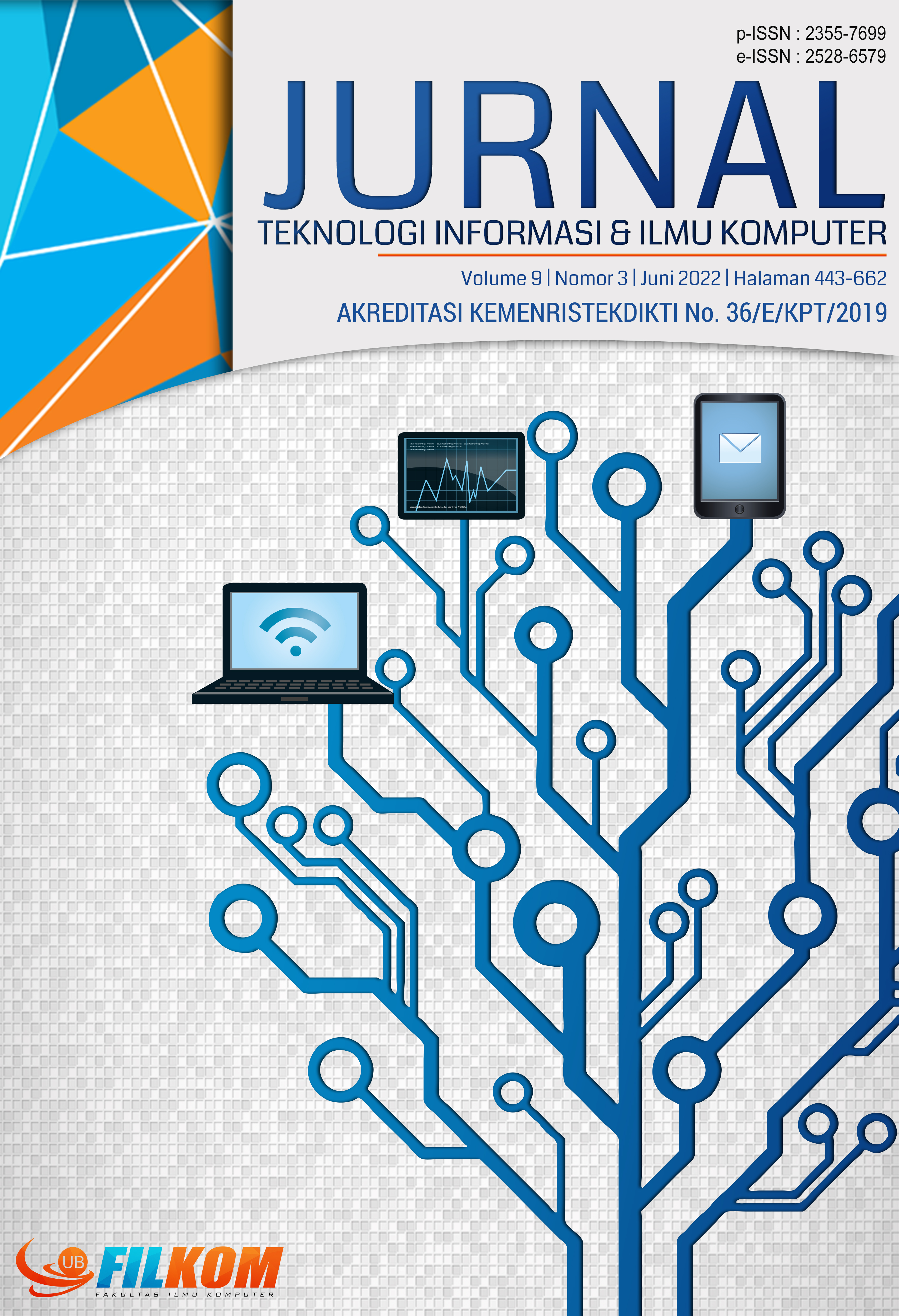Rancang Bangun Purwarupa Pemilah Sampah Pintar Berbasis Deep Learning
DOI:
https://doi.org/10.25126/jtiik.2022934976Abstrak
Pengolahan sampah di Indonesia masih menjadi pekerjaan rumah yang besar dan belum terselesaikan. Menurut penelitian aktual Sustainable Waste Indonesia (SWI) mengungkapkan bahwa 24% sampah di Indonesia masih tidak dikelola dengan baik. Dari sekitar 65 juta ton sampah yang diproduksi di Indonesia tiap harinya, sampah yang paling banyak dihasilkan adalah sampah organik sebanyak 60%, sampah plastik 14%, diikuti sampah kertas 9%, metal 4,3%, kaca, kayu dan bahan lainnya sebesar 12,7%. Sampah plastik yang dihasilkan Indonesia mencapai 1,3 juta ton. Berdasarkan banyaknya sampah yang diproduksi Indonesia, dapat diketahui besarnya peran daur ulang dalam menyelamatkan lingkungan. Peran yang paling utama adalah dapat membantu mengurangi limbah dimanapun dan mengurangi polusi. Langkah awal untuk pengolahan limbah adalah pemilahan. Dengan memilah sampah yang benar, masyarakat dapat dengan mudah mengidentifikasi bahan mana yang dapat didaur ulang dan mana yang tidak. Berdasarkan permasalahan tersebut, peneliti mengusulkan sebuah sistem yang mampu membedakan dan mengenal sampah organik dan sampah anorganik. Dalam hal ini, digunakan salah satu cabang ilmu pembelajaran mesin (Machine Learning) yang mampu mengetahui kumpulan gambar serta mengklasifikasikannya yaitu pembelajaran mendalam (Deep Learning). Salah satu metode pembelajaran mendalam (Deep Learning) yang digunakan adalah Convolutional Neural Network (CNN). Arsitektur tersebut menyerupai saraf manusia dan merupakan salah satu pembelajaran terawasi. Selain itu, peneliti memanfaatkan Raspberry Pi sebagai mikrokontroler, modul kamera Raspberry Pi yang digunakan untuk mengambil gambar, serta Intel Movidius Neural Compute Stick (NCS) yang berfungsi untuk mempercepat proses komputasi sehingga proses pendeteksian lebih mudah. Hal ini dikarenakan perangkat tersebut bersifat portable, cepat dan akurat.
Abstract
Waste processing in Indonesia is still a big homework and has not been solved. According to the latest research by Sustainable Waste Indonesia (SWI) 24% of waste in Indonesia is still not properly managed. From about 65 million tons of waste produced in Indonesia every day, the largest contributor to this is organic waste as much as 60%, plastic waste 14%, followed by paper waste 9%, metal 4.3%, glass, wood and other materials at 12.7%. The plastic waste in Indonesia reaches 1.3 million tons. Based on the amount of waste in Indonesia, it can be seen that the role of recycling is big in saving the environment. It is crucial to help reduce waste anywhere and reduce press down pollution. The very first step in waste processing is sorting. By properly sorting waste, people can easily identify which materials can be recycled and which are not. Based on these problems, the researcher proposes a system that is able to recognize and sort organic waste, and inorganic waste. In this case, Deep Learning, a branch of (Machine Learning) is used to be able to understand a set of images and classify them. Deep Learning method applied here is using Convolutional Neural Network (CNN). The algorithm is like human nerves and is one of supervised learning. In addition, this research use the Raspberry Pi as a microcontroller, the Raspberry Pi camera module which is used to take pictures, and the Intel Movidius Neural Compute Stick (NCS) to speed up the computing process so that the identification process is easier. These devices are portable, fast and accurate.
Downloads
Referensi
INDONESIA, C., 2019. Riset: 24 Persen Sampah Di Indonesia Masih Tak Terkelola. [online] cnnindonesia. Available at: <https://www.cnnindonesia.com/gayahidup/20180401643282293362/riset-24-persen-sampah-diindonesia-masih-tak-terkelola> [Accessed 10 June 2019].
TAOPO.ORG. 2020a. 8 Reasons Why Waste Segregation is Important. [online] Available at: <http://www.taopo.org/microsites/wastedmanila/collection/8reasonswhywaste-segregation-is-important/> [Accessed 4 March 2020].
TAOPO.ORG. 2020b. Waste Generation. [online] Available at: <http://www.taopo.org/microsites/wastedmanila/collection/8reasonswhywaste-segregation-is-important/> [Accessed 8 March 2020].
TORRES-GARCÍA, A., RODEA-ARAGÓN, O., LONGORIA-GANDARA, O., SÁNCHEZ-GARCÍA, F. AND GONZÁLEZ-JIMÉNEZ, L., 2015. Intelligent Waste Separator. Computación y Sistemas, 19(3).
LIU, Y., FUNG, K., DING, W., GUO, H., QU, T. AND XIAO, C., 2018. Novel Smart Waste Sorting System based on Image Processing Algorithms: SURF-BoW and Multi-Class SVM. Computer and Information Science, 11(3), p.35.
YASMIN, HOW, “AI for Social Good,” Re-work, San Francisco, 2019. pp. 17-
, Juni 2019.
MSV, J., 2019. Intel Openvino Brings AI Inferencing to the Desktop and Edge. [online] thenewstack.io. Available at: <https://thenewstack.io/intel-openvino-brings-ai-inferencing-to-the-desktop/> [Accessed 28 January 2020].
THUNG, G., 2017. garythung/trashnet. [online] GitHub. Available at: <https://github.com/garythung/trashnet> [Accessed 10 August 2020].
HOWARD, A., ZHU, M., CHEN, B., KALENICHENKO, D., WANG, W., WEYAND, T., ANDREETTO, M. AND ADAM, H., 2017. MobileNets: Efficient Convolutional Neural Networks for Mobile Vision Applications. arXiv:1704.04861,.
Unduhan
Diterbitkan
Terbitan
Bagian
Lisensi

Artikel ini berlisensi Creative Common Attribution-ShareAlike 4.0 International (CC BY-SA 4.0)
Penulis yang menerbitkan di jurnal ini menyetujui ketentuan berikut:
- Penulis menyimpan hak cipta dan memberikan jurnal hak penerbitan pertama naskah secara simultan dengan lisensi di bawah Creative Common Attribution-ShareAlike 4.0 International (CC BY-SA 4.0) yang mengizinkan orang lain untuk berbagi pekerjaan dengan sebuah pernyataan kepenulisan pekerjaan dan penerbitan awal di jurnal ini.
- Penulis bisa memasukkan ke dalam penyusunan kontraktual tambahan terpisah untuk distribusi non ekslusif versi kaya terbitan jurnal (contoh: mempostingnya ke repositori institusional atau menerbitkannya dalam sebuah buku), dengan pengakuan penerbitan awalnya di jurnal ini.
- Penulis diizinkan dan didorong untuk mem-posting karya mereka online (contoh: di repositori institusional atau di website mereka) sebelum dan selama proses penyerahan, karena dapat mengarahkan ke pertukaran produktif, seperti halnya sitiran yang lebih awal dan lebih hebat dari karya yang diterbitkan. (Lihat Efek Akses Terbuka).












